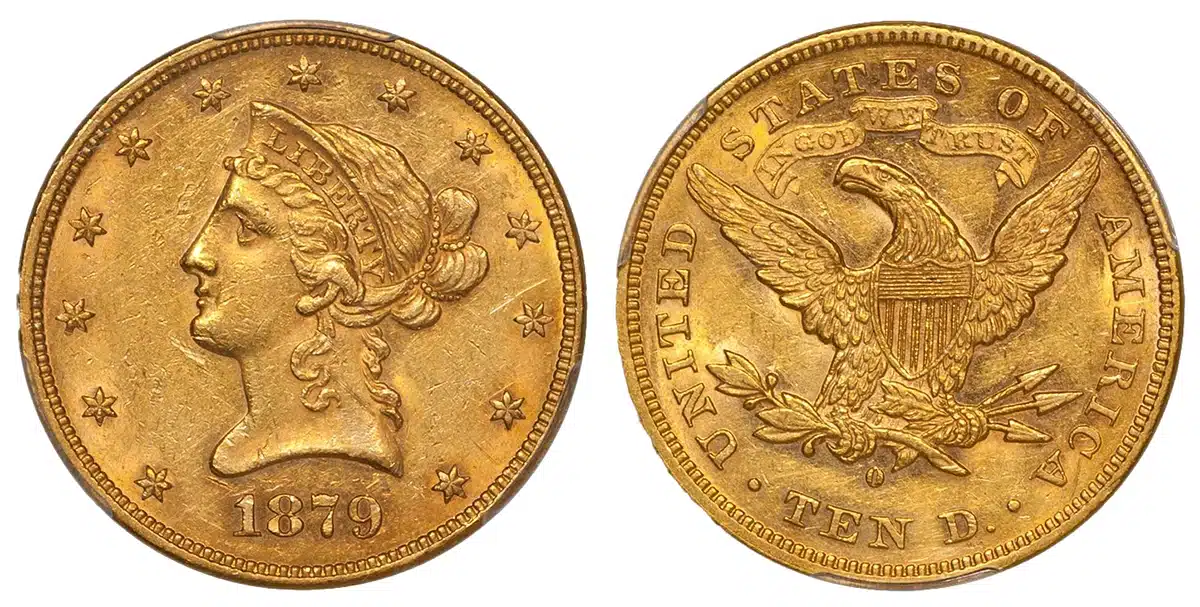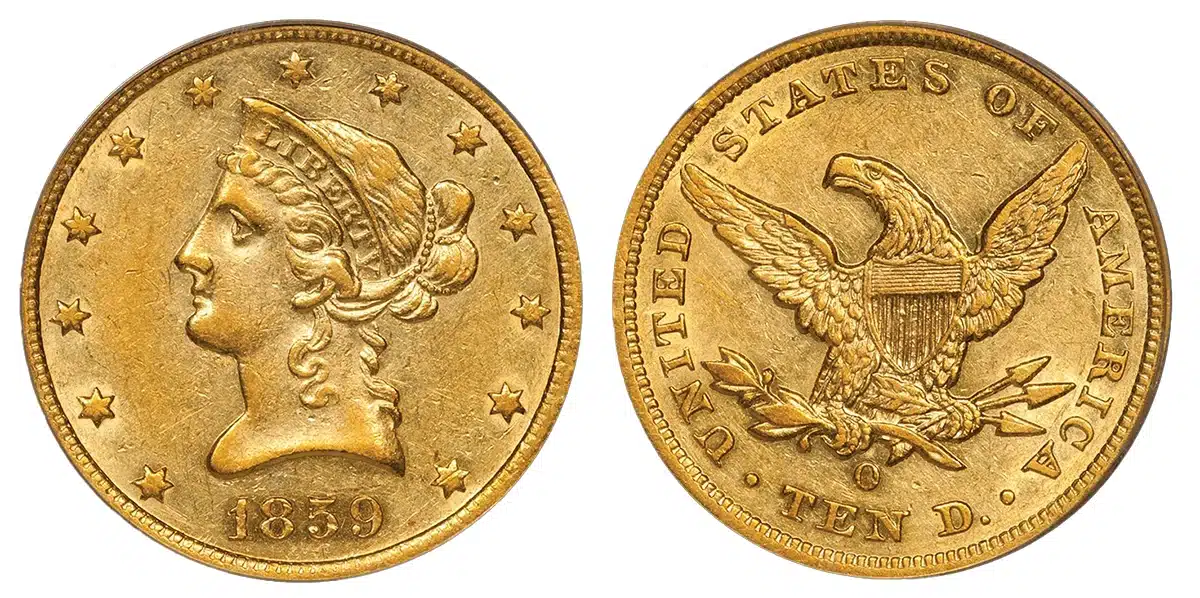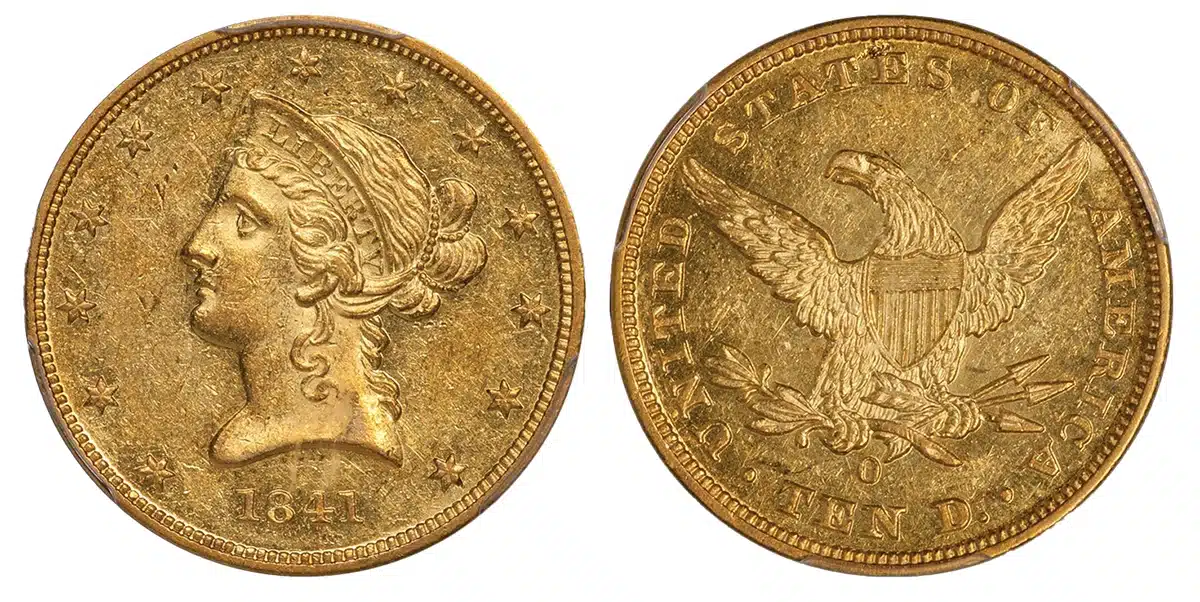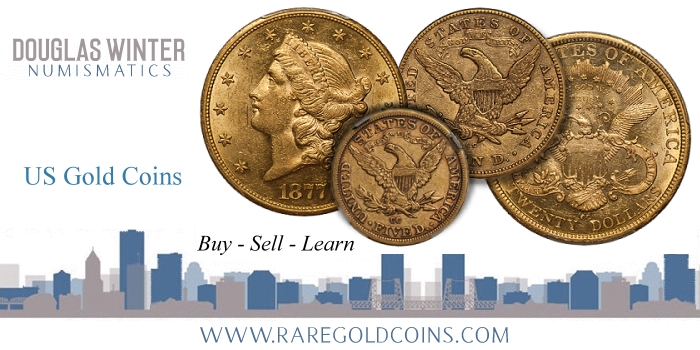By Doug Winter – RareGoldCoins.com ……
CoinWeek Content Partner
I think every collector would agree that the four rarest $10 gold eagles from the New Orleans Mint are the 1841-O, the 1859-O, the 1879-O, and the 1883-O. By analyzing PCGS and CAC population and price data, we should be able to reach some interesting conclusions. For the sake of brevity, let’s stick with coins that represent above-average quality for these four issues, which in this case is AU50 and higher. We won’t include MS60 and finer examples due to the extreme rarity of such coins for each of these four dates.[1]

First, let’s rank each issue by its original mintage figure:
- 1883-O: 800
- 1879-O: 1,500
- 1859-O: 2,300
- 1841-O: 2,500
It should be stressed that, on account of numerous factors, original mintages figures are not always accurate predictors of relative rarity.

Next, let’s rank each issue in terms of overall rarity (total known) according to the updated 2020 version of my book Gold Coins of the New Orleans Mint, 1838-1909.
- 1883-O: 45-55
- 1859-O: 60-70
- 1841-O: 65-75
- 1879-O: 70-80
How do these figures align with the numbers graded at PCGS? First, let’s rank from fewest to most the total number graded at PCGS for each date:
- 1883-O: 38
- 1859-O: 45
- 1879-O: 48
- 1841-O: 69
How many of these coins grade AU50 and finer?
- 1841-O: 18
- 1883-O: 21
- 1879-O: 26
- 1859-O: 29[2]

The percentage of coins graded in AU and finer versus the total number graded skews much higher than I would have thought, ranging from a low of 26% for the 1841-O to a high of 64% for the 1859-O. I have a quick answer for this: the population date for the 1859-O is absurdly high to due to resubmissions, plus many if not most of these coins are overgraded. This will be verified by the CAC population data I’ll be including in just a moment (see below).

Another thing to consider: the 1841-O is a first-year-of-issue coin and it tends to be found in low grades (Fine to Very Fine) when it is available. The 1879-O and 1883-O have different grade distributions, which tend more towards higher grades as they didn’t see much circulation.
Given that so many of the 1841-O and 1859-O eagles graded AU50 and AU53 by PCGS are not fully AU coins, in my opinion, it make sense to change our parameters for high-grade coins and include only coins grading AU55 and AU58 (but not Mint State).
- 1841-O: 7
- 1883-O: 8
- 1859-O: 10
- 1879-O: 13
One would expect that CAC has not approved many of the Big Four New Orleans eagles. Let’s look at the population figures for all AU coins (50-58) and then for high-end AU (55 and 58 only).
- 1859-O: 2; Five total in all grades; one in 55; zero in 58
- 1841-O: 3; 10 total in all grades; zero in 55; one in 58
- 1883-O: 5; Six total in all grades; one in 55; one in 58
- 1879-O: 6; 10 total in all grades; three in 55; three in 58
We can make a few conclusions about each of the four dates from this rarity-based data.
The 1841-O is the most common of the four coins in terms of overall rarity, but it is actually tied for the rarest in terms of high-grade rarity (AU55 and finer). It is most often seen well-worn, and this is mainly due to the fact that it saw much more use in local commerce than the other issues; especially the two With Motto coins, which as a rule saw little use in commerce, and were mostly shipped to foreign countries to pay down incurred in trade.
Unless you really know the series, the 1859-O is misleading based on the submission data. There are a surprising number of AU coins at PCGS but, as I stated above, these figures are greatly impacted by resubmissions and by junky coins in holders. The CAC data confirms this date’s appearance rarity.
Given its low mintage, you would expect the 1883-O to be the rarest of these four dates, and it is from an overall perspective. It is somewhat disingenuous to compare its high grade rarity to the 1841-O and the 1859-O, as With Motto New Orleans eagles made after 1877 tend not to have circulated in the same manner as the coins made prior to the American Civil War.
The 1879-O is not as rare as its low mintage suggests. It is still a very scarce coin (and it is extremely rare in Uncirculated), but it has survived at a higher percentage than its With Motto counterpart the 1883-O.
Now let’s look at PCGS Price Guide pricing information for all four dates in all four AU grades. Next to each price in parentheses, I’ve listed the order from highest to lowest:

Now let’s enumerate the total numbers graded at each AU level by PCGS:

Based on these figures and applying all of the caveats associated with this kind of study, I’ll make the following conclusions:
The 1841-O and the 1859-O are both undervalued in AU55 and AU58. This is especially true for CAC-quality coins. If the sole PCGS/CAC AU58 1841-O became available, it could easily bring $250,000, if not a bunch more. I feel the same way about the 1859-O. The current PCGS price of $60,000 in AU55 is—for a nice CAC coin—way too low.
The 1879-O feels like it is priced properly. This is taking into account that others will likely be located in the coming years, and that they will have a better shot of being CAC-worthy than either of the No Motto issues.
The 1883-O is always going to sell for a higher price than it probably deserves, as a result of its tiny original mintage of 800. That is not to say that this New orleans eagle is overvalued from a macro perspective; it is slightly overpriced in relation to the 1841-O and the 1859-O, but certainly not when compared to an issue such as a better date Carson City eagle from the 1870s, or a low-mintage San Francisco eagle from the Civil War era.
* * *
Notes
[1] The 1841-O is unknown in Uncirculated, while the 1859-O is unique. Both the 1879-O and the 1883-O have an estimated two or possibly three Uncirculated pieces known as of late 2023, with none finer than MS61 for either issue.
[2] In my opinion, these numbers are VASTLY inflated by resubmissions.
* * *
* * *





